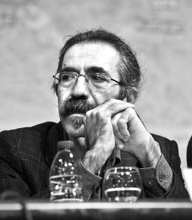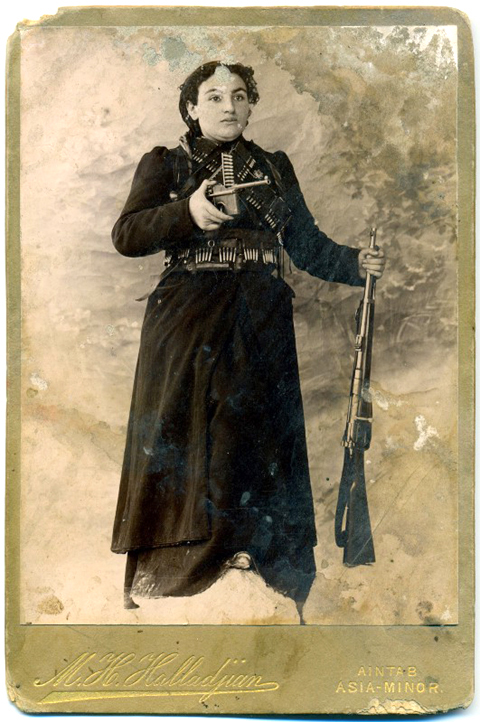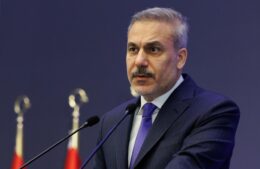The genocide of Armenians living in the Ottoman empire began in April 1915. Its centenary is being commemorated at a time when the Middle East is undergoing another prolonged and many-sided crisis whose features are disturbingly similar to the era of the catastrophic Great War: massacre, arbitrary arrest and murder, displacement and exile, sectarian violence and indeed genocide. Modern Turkey, the principal inheritor state of the Ottoman empire, is – for reasons of history, geography, demography, and ideology – deeply part of this crisis, while trying desperately to insulate itself from its worst effects.
Turkey’s struggle with the inheritance of 1915 is highlighted by the contested status of the events of that year in its public culture. This struggle is itself evidence that long repressed histories are being rediscovered, and entering the public arena in new and challenging ways. A vital role in this process is being played by Armenians in Turkey and the region, among them the writer Vicken Cheterian. In the context of current events, his new book Open Wounds: Armenians, Turks, and a Century of Genocide (C Hurst, 2015) – at once history, memoir, reportage and travelogue – is a major contribution to understanding the present and future as well as the past.
—————-
Anjar, the only Armenian village of Lebanon
When I first visited Anjar, I was already a university student. I grew up in a country enflamed by a series of wars, and we rarely adventured far from our house. During the war, Anjar was famous for two things: being the only Armenian village in Lebanon and housing the headquarters of the notorious Syrian mukhabarat, the much-feared secret services. Among Lebanese Armenians, Anjar is known for its specific dialect, and for being a stronghold of the Armenian Revolutionary Federation (ARF). The road from Beirut to Anjar goes up to the Lebanese Mountains, passing through Alei and Bhamdoun, then climbs up Mount Lebanon until it reaches the Dahr al-Baydar pass.
As we began our descent, the lush Bekaa Valley, and on the horizon the Anti-Lebanon Mountain chain and Syria, became visible. The shop of Yesayi Havatian is on the main highway linking Beirut to Damascus, a few hundred meters from the Syrian border. He has a thin, elegant face, with his hair and moustache greying, and his skin tanned from working under the rays of the Bekaa sun. The shop was crowded; villagers were coming in for his advice as much as for buying agricultural products. “When I studied agriculture engineering at the AUB [American University of Beirut], my problem was to exercise a profes- sion which would allow me to live on my land.” Although he studied agriculture, and he spends his mornings helping his clients from across the Bekaa Valley to cultivate their land, his nights are dedicated to history, on the past of Musa Dagh and the present of Anjar.
Armenian Diaspora foundations that received substantial contribu tions from Calouste Gulbenkian bought Anjar to house the Musa Dagh refugees under the authority of the French mandate. Lebanese neighbours in the nearby Majdel Anjar village took the Armenians into their homes during the winter months. Out of the 5,125 refugees, between 800 and 1,000 perished in the first two years due to the cold and diseases such as malaria. The village was slowly constructed. The six neighbourhoods of Anjar are named after the six villages in Musa Dagh. In 1946, when the Soviet Union began to encourage Armenians to repatriate, half of the refugees – primarily those who were sympathetic to the pro-Soviet Hnchagyan Party – decided to move to Soviet Armenia. They currently live in a village called Musa Ler, near Yerevan.
As one of the villagers was toiling the earth, he made a sensational discovery: the ruins of an Umayyad-era (661–750) town, one of the archaeological gems of eastern Lebanon. The city was built in the eighth century under Caliph Walid Ibn Abd al-Malak (705–715); it was on the crossroads of the trading routes stretching north-south from the plane of Homs to Palestine, and east-west linking the Umayyad capital Damascus with coastal towns such as Beirut and Sidon. The city is divided into quarters and neighbourhoods, with the palace and the mosque occupying the highest point, and the shops of the market stretching out from these buildings; the town was supplied with sewage and water distribution systems, with high city walls supported by forty towers. The town exemplifies the exquisite Arab architecture from the early period of Islam, and in 2010 these Umayyad ruins in Anjar were placed on UNESCO’s list of sites of Outstanding Universal Value.
Yesayi Havatian, the shop-owner, went to Musa Dagh with his family for the first time in 2001. He was already highly familiar with the place after having read every book or report he could about the home of his ancestors, but he now wanted to see it with his own eyes. He was able to speak to the villagers of Vakifli in his own dialect. He visited the village of his grandparents, Veri Azor, adjacent to Kheder Bey, but no trace of their presence remained. Two major pilgrimages took place in 2004 and 2010, ending with a fiesta on 13 August in which the entire village of Vakifli participated. After sixty-five years, the inhabitants of Vakifli finally felt they were not alone.
Aintab
My maternal grandmother was born in the town of Aintab, from which her entire family, the Nazarians, also hail. The town has since been renamed as “Gazi-Antep” (“gazi” meaning conqueror in Arabic, or holy warrior in Turkish) due to its role in Kemalist mythology, and the battle between Turkish nationalists and the French army in the town (as well as Marash and Urfa) in the Cilician war (May 1920-October 1921).
I had travelled to Aintab in order to meet some Syrian refugees. On the first evening, I went to a café, Café Papirüs, in a large stone house with some friends when the owner approached us and asked where we were from. I answered, in my limited Turkish, that I was Armenian; he then took my hand and led me to one of the windows, where he showed me an inscription that was clearly written in the Armenian alphabet.
Hanife, the café owner, invited me to come again the next day, as he would like to give me a tour of the building. Although part of the building was being renovated, what I saw was very impressive. The building had once belonged to a powerful and wealthy Armenian family from Aintab, the Nazaretians. A black-and-white portrait of Nazaretian was placed next to the window of the visiting hall, with colourful paintings of angels and natural scenery decorating the walls. In another room there were black-and-white portraits on the wall, surrounded by beautiful frames. The names read: Mehmet Akif, Mehmetcik, Mithat Pasha, Abdulhak Hamit.

Surp Asdvadzadzin Church was converted into a prison for a period, before being turned into Kurtulus Mosque. The church is one of the largest known Armenian churches in the Asia Minor built in 1892.
There is a building in the town, on the Ataturk Boulevard, a short distance from the café, which resembles the architecture of a Catholic church; the façade bears the scars of bullet holes from the War of Liberation. Further up the hill there is an imposing mosque known as “Kurtulush Jami” (“Kurtulush” means “liberated” in Turkish). I was aware that there also used to a big Armenian church here called “Surp Asdvadzadzin“, which had been built at the end of the nineteenth century, but which had been converted to a mosque after 1915. I eventually found this building in the middle of a neighbourhood with old, crumbling houses, some of which had windows in the shape of a cross. This was one of the three Armenian neighbourhoods of Aintab known as Kayajik, Kastelbashi and Hayik Hill (now Tepe Başi).
Surp Asdvadzadzin Church was closed. But there was a guardian sitting in front of it. For a few Turkish liras he opened the door and let me in. I was alone. The emptiness underlined the loneliness of the place. It is a huge building of white stones with a large imposing dome. From the street it looks imposing, as it stands on the side of a hill. A huge Turkish flag was hanging where the altar used to be. In the 1920s, this building had been used as a prison, before being converted to a mosque in the 1980s. The church’s bell-tower had been converted into a minaret, while one of the other minarets that had been added to the building referred to the date of construction: 1985. There is a cultural centre on the same street, 100 metres from the church. This building also used to be an Armenian church – the Surp Bedros Armenian Catholic Church – but it is now called Omer Ersoy Kültür Merkezi. For many years it was used as a warehouse until it was “discovered” and turned into a cultural centre.
One of the best ways to learn about the hidden history of a city is to find someone with local roots to guide you and introduce you to aspects and individuals that you would otherwise not encounter. When I was in Aintab, my guide was Murad Uçaner. Before relaying the hidden story of the city he unveiled to me, it is important to take note of his life history.
Murad’s story

Murad Uçaner
Murad Uçaner is an electrical engineer who was born and raised in Aintab. In 2005 he was involved in renovating an old house in the Kayacik neighbourhood, in old Aintab, near Papirüs café. While removing some wood that covered the walls in one of the rooms, he discovered a curious picture: it was of a young woman, holding a pistol in one hand and a rifle in another. She had cartridge belt around her waist and two others across her chest. The lower end of the picture contained the words “M.H. Halladjian, Aintab Asia- Minor”, which Uçaner assumed to be a reference to the photographer. On the other side of the picture he saw some writing he did not recognise, though it may have been Arabic. It read “21”, followed by something which was illegible, and then the year of 1910.

When Uçaner showed his friends the picture, he was told that the wording was neither Arabic nor Ottoman Turkish. One of his friends suspected that the wording could be Armenian. At a later date, and entirely by chance, he met a group of tourists who were visiting Aintab, and who were talking in a language he did not recognise. He approached one of them and asked them whether they could tell him what was written on the old picture. They could: it was in Armenian. It said:
Hankutsyal heros Kevork Chavushi ayri Heghine. Mer hishadagi nvere 21 hulis 1910, Ho. Hi. Ta. [Heghine widower of hero Kevork Chavush. The gift to our memory. July 21, 1910, ARF.]
After researching Kevork Chavuch, Uçaner learned that he had been born near Sasoun and that he had been an Armenian fedayee (guerrilla fighter). He took part in the Sasoun uprising in 1894, after which he was arrested and imprisoned. When he managed to escape he took part in the second Sasoun uprising of 1904 after joining the ARF. In 1907 he was wounded in a skirmish with Ottoman army soldiers and later died.
The discovery of the picture and its story shocked Murad. He did not know that Armenians had lived in his town; nor did he know a great deal about the Armenians in general. This meant he did not know the history of Aintab, the past of his own city. It became his obsession – he even called his cat “Kevork Chavush”. One day a group of Armenian tourists were visiting the old town when a colleague of Uçaner shouted out the name of the cat “Kevork Chavush, come back here!” One of the visitors turned around and asked who had given that name to the cat. The man answered that it was Murad Uçaner, but that he was not currently available. The tourist, Armen Aroyan, decided to wait until he came back.
Aroyan is a Californian Armenian who has organised tourist trips to the Armenian homeland for many decades, and has an encyclopaedic knowledge of Armenia and the history of the Armenians. He has organised over sixty tours to former Armenian monasteries and has visited more than 600 mountain villages. Aroyan gave Uçaner a copy of K. Sarafian’s Brief History of Aintab.
Uçaner started learning to read and write Armenian in order to learn the true history of his city, which the authorities had tried to destroy or silence. He is currently translating Aintabi Koyamarde (Aintab’s Struggle for Survival, in Armenian) into Turkish.
During this period he began to research the history of the house he was involved in renovating. He learned that it had once belonged to one of the wealthy Aintab Armenian families, the Danielians. It was currently owned by Ahmet Dai, a local potentate: “Ahmet Dai is not interested in the history of the house,” Uçaner told me. “Most wealthy people in this town are not interested in the history of our city, because if they do, they might discover the real face of their grandfathers.” Heghine, the young, armed woman in the picture, was the widow of Kevork Chavush. “I presume Heghine visited Aintab and stayed with the Danielian family,” Murad said. Aintab had a long tradition of receiving Armenian migrants from Sasoun who were bakers by profession.
Murad Uçaner is currently working on a book to reconstruct the life of Aintab Armenians in the nineteenth century. I first met Murad in November 2013. He was accompanied by his friend, the former journalist Alev Er, who had founded the Taraf daily newspaper and who was in Aintab to undertake research for a book on Sabiha Gökçen.
We first visited Surp Asdvadzadzin Church, now known as Kurtulush Camii. As we walked around the church, Uçaner lifted the big Turkish flag which was still hanging on the wall where the church altar used to be to reveal traces of two cross carvings – the flag had not only been placed in the church to indicate that it had been “liberated” but also to hide the remnants of its Christian past. We then toured the narrow streets above the Kurtulush Camii. One of the streets was called “Heyik Mescit Cikmaz Sokak”, while a second was called “Heyik Müslüman Sokak“. Then we came to another street where the words “Hayik Imam Sokak” had been written, yet the first word, “Hayik”, had been painted over and changed to “Heyik“. In Armenian, the Armenians call themselves “Hay”, with the plural in classic Armenian (krapar) being “Hayk” – “Hayk” had become “Heyik” in reference to the Islamised Armenians who lived in this neighbour hood whose names were used as street names. Hayk in Turkish becomes Heyik, and the mistake on the third street sounds like it was first written in Armenian, and then “corrected” to sound more Turkish. People might forget, but the streets of Aintab remember.
In the evening, I met Murad Uçaner near the former Catholic church and he led me into an apartment where a party was being held. When I entered, Murad introduced me to Erol Akçay, a jovial man in his late forties who had previously served as a captain in the Turkish army. When I was introduced to him, since I was Armenian his instant reaction was to ask me for forgiveness – he told me that he did this every time he met an Armenian, and that it was a moral imperative to do so. He then told me his story: he had been in the army in the 1990s and was involved in the anti-PKK war, but refused to take part in the slaughter of Kurdish villagers and was imprisoned for eight months, and later stripped of his rank.
I then asked him how he had come to learn about the Armenians. He told me he had learned about the Armenians as a result of his childhood: he had been born in Aintab, in the Armenian Kestelbashi neighbourhood immediately below Surp Asdvadzadzin church/Kurtulush mosque, and grew up in one of the old Armenian houses. As a teenager, he often wondered why the houses in his neighbourhood were different from those in other parts of the town, and after the ASALA terrorist attacks his interest was further kindled with regard to why the Armenians should be seeking to attack Turks. Although there were few available resources on the Armenians at this time, he eventually read Meguerdich Margosyan’s Gyavur Mahallesi (The Infidels’ Quarter), a book concerned with the Armenians of Diyarbakir. After reading this book he went on to read many more about the Armenians in a range of different cities, and learned about their fate. He said that it was then that he realised that everything he had been taught was a lie, and decided that every time he met an Armenian he would hug them and apologise.
The Aintab volunteers
Prior to the First World War, Aintab had 80,000 inhabitants, 36,000 of whom were Armenian. All of the Armenians were artisans and merchants. The Aintab Armenians were deported and massacred in the dark years of 1915–16, during which half the population per ished. After the war, the population of the city had reduced to 40,000; the surviving Armenians then returned, increasing the population to 55,000 by 1919, among whom 18,000 were Christians. When the French forces replaced the British in Aintab on 29 October 1919, the local Armenian population apparently received them with “cries of joy”.
The French Légion arménienne used Aintab as its headquarters. The local Turkish notables held an antagonistic attitude towards the French forces from the outset, with violent incidents taking place in Aintab as well as in neighbouring Marash. In April 1920, some 150 Armenian men formed a group of volunteer fighters led by Colonel Levonian, and joined the French forces when the town was besieged by the Turks in order to defend the Armenian quarter. At the end of the Cicilian War the city had largely been destroyed – the mosques and converted churches are still peppered with bullet and cannon holes – and the population fell as low as 28,000.9 Aintab was a shadow of its past.
When I asked my friends in Aintab how many Armenians currently lived in the town, they told me there were many thousands, but that no one would be prepared to admit this as they would lose their jobs and it would cause other problems for them too.
From Caesarea to Diyarbakir
When travelling across Turkey, it is very difficult to find traces of Armenian life without trained eyes. I took a night bus to the central Anatolian city of Kayseri, the classic Caesarea. The city is one of the “Anatolian tigers”, the capital of the Turkish textile industry. Gregory the Illuminator (302–325), the founder of the Armenian Church, was first introduced to Christianity in Caesarea. The city is one of the few Turkish cities east of Istanbul with an Armenian church: Saint Grigor the Illuminator.
The neighbourhood around the church is composed of new high-rise buildings and old crumbling houses. The latter were where the once thriving Armenian community had lived. Before the First World War there had been a large and prosperous Armenian community in Kayseri; the province had an Armenian population of over 52,000 living in thirty-one towns and villages, who owned forty churches and seven monasteries, as well as fifty-six schools with 7,019 pupils. In Kayseri itself, a total of 18,907 Armenians lived in the town, constituting 35 per cent of the population.10 There are only three Armenian families in the town today. The other church in Kayseri, which stands near the city walls, is called “Surp Asdvadzadzin” (Holy Virgin Mary), but it has since been converted into a sports club.
The nouveau riche are currently building mansions in Talas, a town located on the side of a mountain a few kilometres away from Kayseri. I began to wonder why the wealthy inhabitants of Kayseri were not renovating the beautiful old houses in the town. Was it because they knew that the houses did not belong to them? At the lower side of the town, the foundations of the Talas American School, a boarding school which once served Greek and Armenian children from the region, can still be found. Inside the town itself there are numerous old houses, mostly inhabited by poor families. The rich here prefer new houses, or to live in high-rise buildings. There is a structure here that is reminiscent of a Byzantine church, the Panaya Greek church, built in 1886, but it is now the “New Talas Mosque”.
As I walked through the former Armenian quarter we found an old mansion that had been left in ruins. The local guide who was accompanying me said that it had once belonged to the Gulbenkian family, the ancestors of the legendary Armenian oil magnate. Although the Gulbenkian family wanted to renovate the house, the Turkish authorities had consistently failed to provide them with the requisite authorisation to do so. Today there is only one Armenian family left in Talas.



















